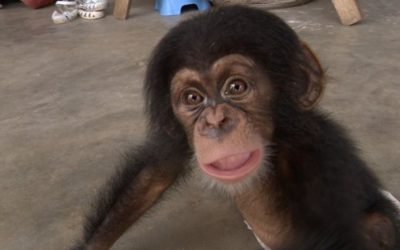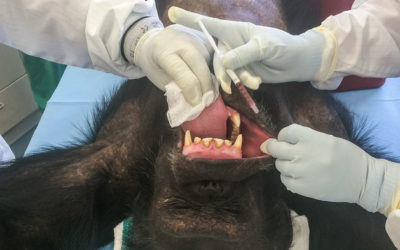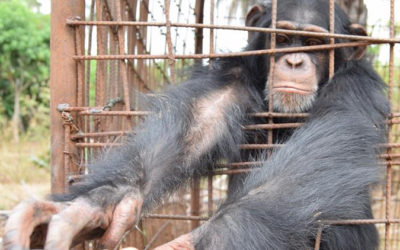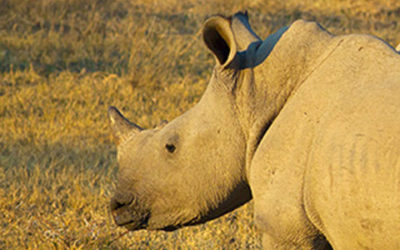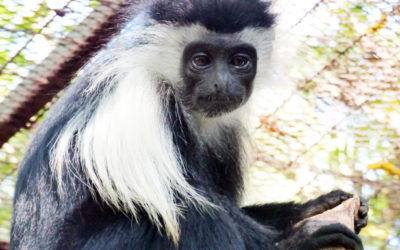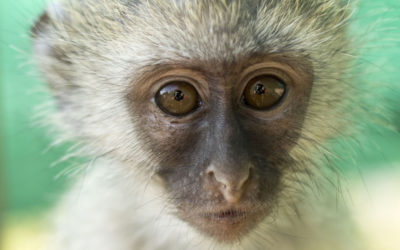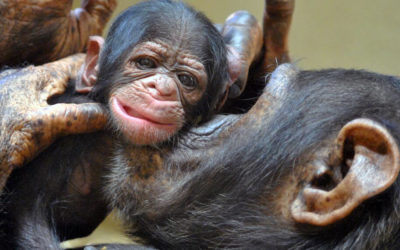Japan’s Only Ape Sanctuary Arose from a Pharmaceutical Research Facility
Japan’s apes are helping us to better understand our closest relatives
by Natasha Tworoski
High in the hills of the Kumamoto Prefecture in southwestern Japan are some unexpected residents. This is where 58 chimpanzees and 6 bonobos call the Kumamoto Sanctuary home. An extension of Kyoto University’s Wildlife Research Center, the facility is the only ape sanctuary in Japan and many of these chimpanzees have been rescued from the biomedical research industry. While they now live in proper social groups, receive healthy diets and have comfortable lives, this was not always the case.
The sanctuary site was once owned by a drug company, which housed some of the chimpanzees and organized for other institutions to also receive chimps for biomedical research. Here, like other similar facilities in Japan, US and Europe, the chimps were kept in small, cramped individual cages and intentionally infected with diseases such as hepatitis, HIV and malaria. They justified doing this because chimpanzees are our closest relatives and so the data collected could allow treatments to be created that could save human lives.
This is a misleading statement, however. Take hepatitis C, the strain infecting over 200 million people worldwide. In humans, it can lead to cirrhosis of the liver and liver cancer, and can be transferred from mother to fetus. None of these symptoms are seen in chimpanzees that have contracted hepatitis C. If chimpanzees aren’t affected by a disease in the same way humans are, research to develop medicine for humans with the disease based on chimpanzee treatment is inherently flawed. Additionally, since 2003, scientists have been able to grow hepatitis C in a cell culture, effectively testing treatment options without exposing animals to cruel conditions. With constant advancements in science, the use of non-human primates for medical testing is not justifiable.
After a long discussion between the company and primate experts in Japan, it was agreed that the chimpanzees would be turned over to form a chimpanzee sanctuary in April 2007, with the company continuing to make a sizable financial contribution towards their care. It is part of Kyoto University’s Wildlife Research Center, which studies endangered species worldwide.
One of the most impressive things about Kumamoto Sanctuary is what they have achieved by housing so many chimpanzees with inhumane pasts. Due to their high intelligence and complex social structure, it is critical that young chimps live with adult chimpanzees so they can learn how to interact properly with one another. When they skip this step in life, it can be difficult for them to later on integrate into a social group as adults. The complications of the situation escalate quickly when none of the individuals have had normal juvenile stages.
The sanctuary has renovated the enclosures the chimpanzees are in, but space is still a constant concern. To utilize the area they have, nine social groups have been formed on the property. In the wild, a community of chimpanzees would have a defined territory, but not all individuals stay together throughout the day. Instead, they typically break off into smaller groups and forage within the territory. This is called a fission-fusion society. To replicate this and also to prevent too much tension building in a shared space, some of these chimpanzee communities can be split into temporary subgroups that are also rotated. Doing this requires caretakers to know each chimp well, so individuals that have close relationships don’t get split-up or individuals that don’t get along well aren’t kept together for too long.
In addition to housing challenges, the sanctuary has excelled at other aspects of care. The apes at one point were only receiving 10 different food items, but that list has now expanded to 71. A weekly rotating enrichment calendar means the way food is presented is different every day, For example, one day may require the chimps to break down branches to make tools to twig out food items from holes drilled into logs, while another day they may have to forage through boxes stuffed with straw in order to find their meal.
Besides having a safe, secure home, these apes are also helping us to better understand our closest relatives when scientists from around the world come to observe them. Both chimpanzees and bonobos share the same common ancestor with human beings, meaning we share the same percentage of DNA with each species, a staggering 98.7%. For aspiring Kumamoto Sanctuary researchers, being invited to the sanctuary to conduct observations is a competitive process and a huge honor. Many of these studies investigate how these two species solve problems in comparison to humans, but the topics are quite varied. Earlier this year, the sanctuary revealed one of their chimpanzees has a genetic disorder comparable to Down syndrome in human beings, which was initially suspected based on physical traits she displayed and later confirmed when her DNA was tested and she was found to have an extra chromosome. To see some of the publications based on research at Kumamoto Sanctuary, click here.
A huge thank-you to Professor Satoshi Hirata and the staff at Kumamoto Sanctuary for sharing this information with PASA and also for all they do for ape welfare.

The chimps can choose to participate in touch-screen tests for special treats, which helps researchers see how they solve problems. Photo taken by Satoshi Hirata.
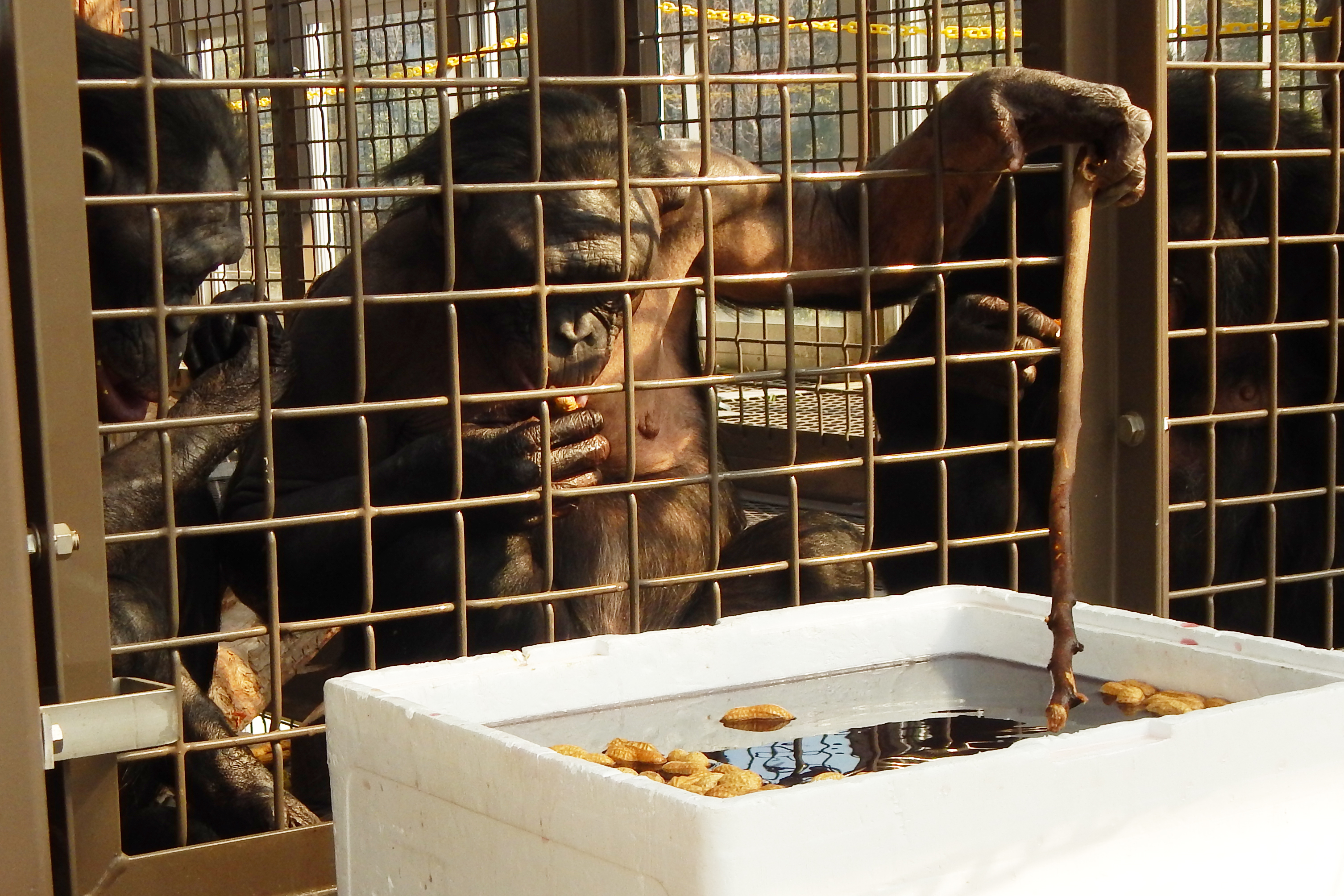
As a special treat, bonobos use sticks to twig floating peanuts out of a tub filled with juice.
Next Posts
What Can You Accomplish by Donating to PASA?
Although PASA started as a way to connect primate rehabilitation centers, it has grown substantially over the years and now strengthens its members in more ways than ever.
Nemley Junior: A Tiny Chimpanzee with a Not-So-Tiny Impact on Illegal Wildlife Trade
Nemley Junior: A Tiny Chimpanzee with a Not-So-Tiny Impact on the Illegal Wildlife Trade A heartbreaking tragic death of an orphaned baby chimp and the unsettling aftermath by Jennifer Harris Nemley Junior, a tiny orphaned baby chimpanzee, was about to be stuffed into...
Are Conventional Conservation Approaches Holding us Back? The Ethics of Give and Take
Are Conventional Conservation Approaches Holding us Back? The Ethics of Give and Take Working with corporations to forge new paths to conservation by Natasha Tworoski When it comes to complex issues such as protecting our remaining wildlife and wild places, solutions...
A Wild Idea, Literally: Research on Vaccinating Endangered Wild Apes against Deadly Ebola
A Wild Idea, Literally: Research on Vaccinating Endangered Wild Apes against Deadly Ebola Viral mutation and spread to wild apes are the risks. By Jen Harris Since the 1990s, an estimated one-third of the world’s gorilla population and a similar fraction of...
Four Rescued Chimpanzees in Desperate Need of Help!
Four Rescued Chimpanzees in Desperate Need of Help! Smugglers' leader and several others arrested. By Natasha Tworoski Four young chimpanzees were just rescued from deplorable conditions at a roadside facility in Guinea. A collaboration between WARA Conservation...
New Study Shows the Impact of PASA Members on Primate Protection
New Study Shows the Impact of PASA Members on Primate Protection PASA wildlife centers are making a difference through education, community development, animal rescue and long-term care. By Natasha Tworoski Across the continent of Africa, wildlife sanctuaries are...
Brutal Attack on Rhino Sanctuary
Brutal Attack on Rhino Sanctuary Staff were beaten and rhinos killed for their horns By Natasha Tworoski An incredible act of violence occurred late at night on Monday, February 20th at the Thula Thula Orphanage in South Africa. Several staff and two rhinos were...
Returning to the Wild: Possible but Costly
Returning to the Wild: Possible but Costly First Colobus troop going back to the wild! By Natasha Tworoski The coast of Kenya is home to a spectacular range of wildlife. Here you will also find dedicated PASA member, Colobus Conservation. The face of this organization...
Five Rescued Monkeys Make the World a Better Place
Five Rescued Monkeys Make the World a Better Place Finding safe haven for themselves and other species. By Natasha Tworoski If video footage of extremely adorable baby monkeys is your thing, boy are you in luck! A new film, “The Vervet Forest,” is now being screened...
We All Get By With a Little Help from Our Friends
We All Get By With a Little Help from Our Friends It took a human to show Nina how to care for her new son. By Natasha Tworoski When humans prepare to have their first baby, it can be a nerve-wracking time filled with uncertainty. Fortunately, there are countless...


